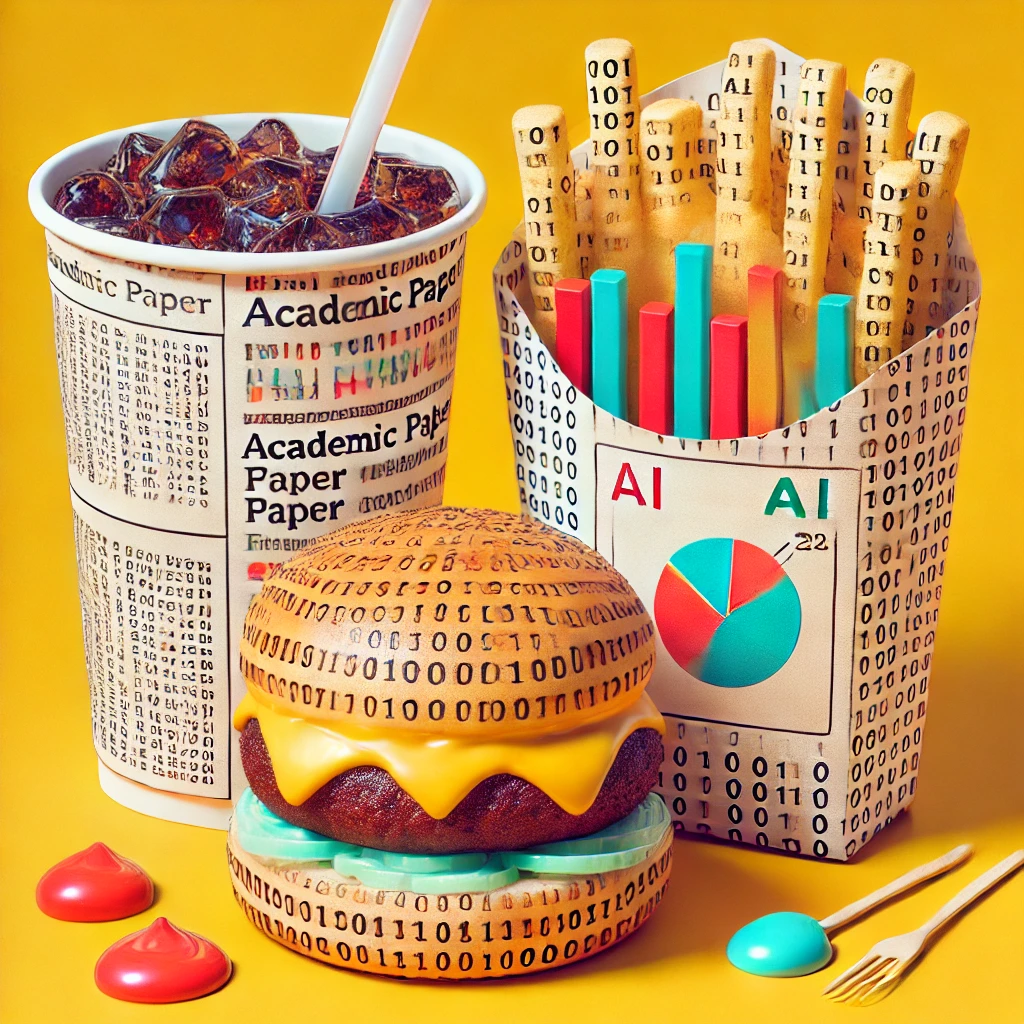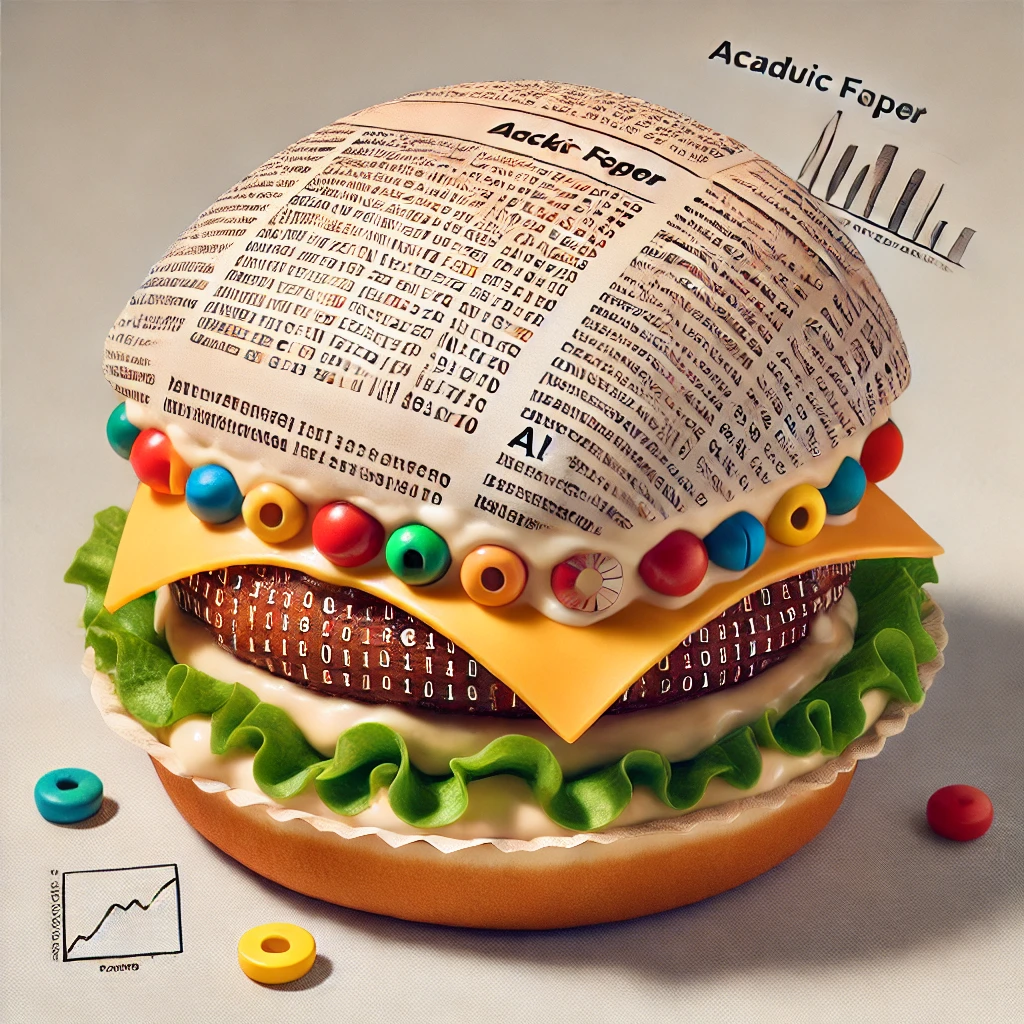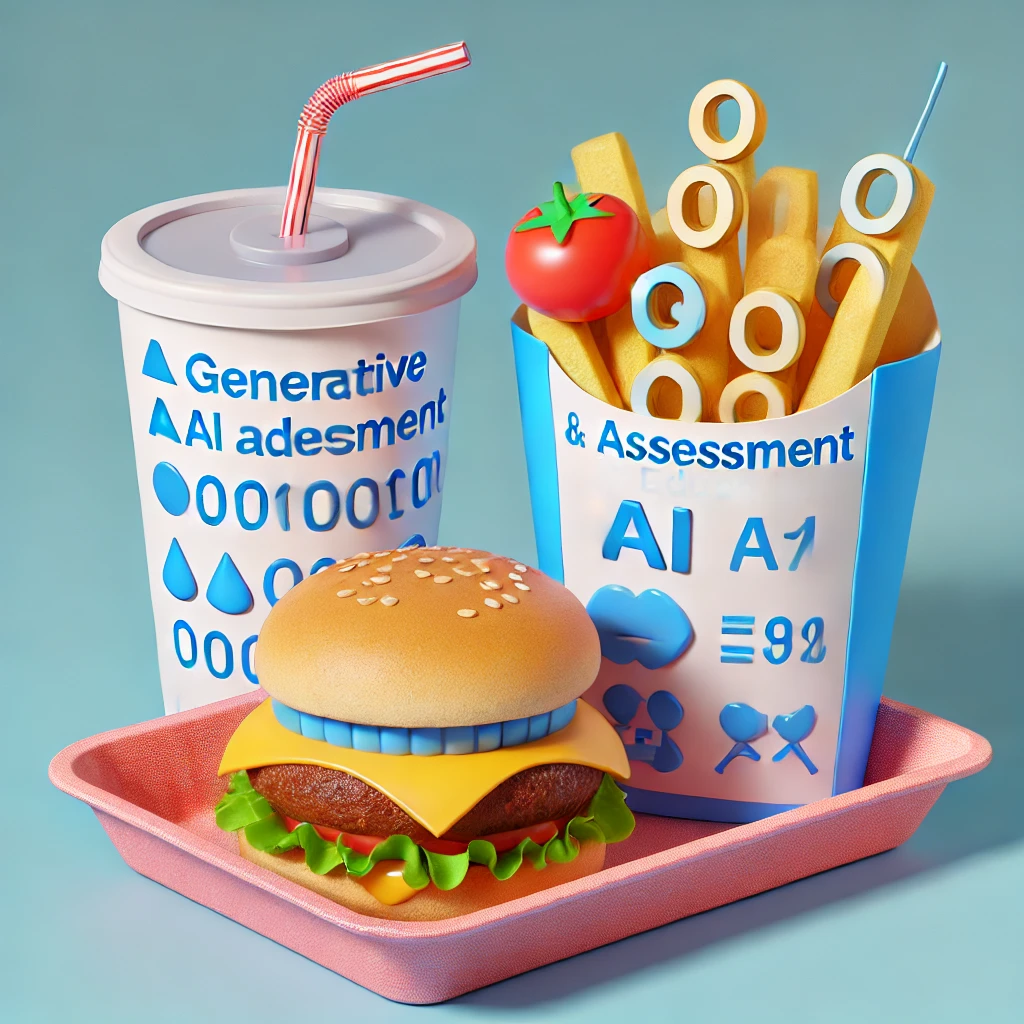Junk Food Summary of a Very Healthy Paper on GenAI and Assessment
The Junk Food Summary of a Healthy Paper
Some papers are like a giant bowl of Quinoa salad with no dressing: you know it is really good for you but you just need a lot of self-discipline to finish it.

Here is one such paper: Kaldaras, L., Akaeze, H. O., & Reckase, M. D. (2024). Developing valid assessments in the era of generative artificial intelligence. Frontiers in Education, 9, 1399377.. It has a whole lot of great stuff, but, I have to say that reading through it requires a couple cups of coffee to say the least.
So I decided to create a “junk food” version summary of this paper: it will be unhealthy and probably miss a LOT of the intellectual vitamins in the original salad bowl, but, hopefully it tastes better 😄
The Core Message (sandwiched between two pieces of bread)
Suppose we want to know if someone really knows how to make a burger, before we ask the person to actually make one. In traditional classroom education settings, we would have given out a multiple choice tests containing questions such as “Which of the following ingredients are included in a burger?”. Now, with GenAI, we can ask the person: “Tell us, how do you make a burger?” and use GenAI to both score the answers and analyze the answers. Very nice. But how do we know if those new GenAI based tests really reflect someone’s ability to make a juicy burger? That is the question of test validity.
The future of tests
What should test in the future be like? The authors listed three things:
- Emphasize and real-world application rather than memorization.
- Able to assess learning as a process
- Able to provide meaningful feedback for growth.
In other words: Do you know how to make a burger? Don’t just memorize the recipe or the ingredients. Between burger newbie and burger master, which stage are you at? Do you need to practice flipping the pattie, or learn more about different types of cheese?
So how can we build those future tests? And how can GAI make creating those tests much more feasible?
Behind every test there should be a construct. Wait, a what?
“A construct refers to an unobservable and possibly hypothetical entity or concept.” that the test is supposed to measure. Personally, I think that this definition has an important implication: if an entity/concept is unobservable and hypothetical, then it is “constructed” by humans through language and social consensus, rather than an objective existence. I also think that “unobservable” should be “not directly observable”, since a completely unobservable entity sound like the famous “invisible dragon in my garage”.
The more I think about the definition of a “construct”, the less I think I understand it. Below is a “junk food” version of how I currently understand this concept, which is highly debatable but hopefully has some truth to it:
Whether a sandwich is a hamburger, a cheeseburger, or a bacon burger, is an objective existence that is not hypothetical, nor purely constructed (one can always question what counts as a piece of cheese, for example, but in most cases it is obvious.)

“How would you like your burger cooked”, refers to a “constructed” concept. Terms such as “medium rare” are constructed by humans, and no two restaurants can 100% agree on how rare is “medium rare”. But this is still not a “construct”, since the “cookedness” of a beef pattie is directly observable (or tastable) if you cut it open or bite into it.
“How good is the guy making the burger” is likely a construct. Yes, you can observe the person cooking a burger, but “goodness” of burger cooking at some point would involve brain states such as knowledge related to burger and cooking, physical aptness such as hand-eye-coordination, etc. You can’t cut-open someone’s brain, and even if you sort of can (for example, using fMRI), you won’t be able to directly see a “burger making” area as assess its goodness. You are also assuming that the “goodness” of burger cooking can be mapped onto a one dimensional scale from “terrible” to “master”. All of those are hypothetical, and needs to be validated.
“How creative is this person when it comes to making burgers” is totally a construct because 1. you can’t observe creativity directly, and 2. I just made the ** up.
In fact, after writing this all down, I think we either need a much better definition of “construct”, or give up on the idea of a “construct” altogether.
The construct validity: is a good burger really good?
“Construct validity relates to how well an assessment instrument represents and reflects the construct of interest.The validation process involves accumulating multiple relevant evidence sources to provide sound scientific support for the proposed interpretation of the assessment results”
Say we have some kind of a test of how good a burger is, without actually tasting it. The “construct” here is the goodness of a burger, and testing the “construct” validity is relatively straightforward (just relatively). Give some burgers to a large group of people and ask them to rank it. Then compare the ranking to the test results, and you have the construct validity of the test. In addition, examining how uniform people rates those burgers will give you a validity measure of the construct itself, which may also be called construct validity I guess?
Now validating a real “construct” is much more difficult, since it cannot be directly observed, nor can we easily define some ground-truth, such as the taste of a burger. So, multiple sources of evidences needs to be collected to validate that the test is actually testing the “construct” we are interested in.
How you use the test score matters!!
“Consequently, when assessment results are interpreted in multiple ways—for example, as a summative measure of what students have mastered or as a predictive measure of future performance—each of these intended uses of the assessment result must have evidence to support the desired inference.”
This is an extremely important point in my opinion, and is all too often completely left to the side. Say we have a valid test of how good tasting a burger is, yay! Now let us use that to decide which worker wins the “best burger maker” award based on how good their burger is! Sounds fair? What about a burger maker who works at McDonalds vs. a burger maker who works at a 4-star hotel restaurant? That’s obviously not fair.
But what about “you need to get a C+ average to receive scholarship”? Or “C+ in Calculus I” to be able to take physics I? We don’t even think about those questions, let alone doing something about it. Oh, and student rating > 3.0 to be eligible for teaching award, let’s not even go there….
When a test result is used for a purpose, there needs to be evidence of that particular use
Construct proficiency levels: How would you like your eggs cooked??
The egg is an amazingly precise thermometer. As the temperature rises, it goes from raw egg to runny yolk, to soft boiled to hard boiled, following a precise, well defined sequence. The white solidifies faster than the yolk, making runny yolk egg a reality. We know that process extremely well (Harvard Science of Cooking uses it as an example!), simply because we can crack open the egg and look inside at any point.
How many stages are there when a student transitions from novice to expert? Unfortunately, cracking students’ head open and peak inside is and will never be an option (although perhaps every teacher had thought about it at some point). So “construct proficiency level” becomes really hard to measure, especially since in hypothetical “construct” itself may not even be a good hypothetical model of the brain.
Generative AI(GAI) provides a way to look into the mind and find those transition patterns, argues the paper. For example, one could ask students to write their response to a question, and use LLMs to find patterns and clusters in student answers, through for example text embedding and clustering process. One could either give the same or similar problem repeatedly to a small group of students and observe the transition of answers, or to a large enough student population, assuming that there must be students with different levels of proficiency of the construct, or both. This process uses LLM’s ability to detect similarity in language, and that language serves as the best representation of the mind (see this post) that humans have. Clearly, using GAI to do this will be much easier and more streamlined compared to having humans code hundreds of student responses.
Five sources of evidences of construct validity
Evidence sources outlined in the Standards for Educational and Psychological Testing include:
- Evidence based on test content;
- Evidence based on response process;
- evidence based on internal structure;
- evidence based on relation to other variables;
- validity generalization.
Yes, it is much harder than the hardest boiled egg.

Evidence based on test content: is it really about the burger?
“This type of evidence relates to analyzing the relationship between the test content and the construct it is intended to measure.”
A burger test should be about burgers, so the question “how do you use fork and knife to eat food” has limited content validity, unless the correct answer is “you don’t”.
A physics test should be about physics. Yet, I was going through all the back of chapter problems of a popular textbook recently and was “struck in the head” by a baseball problem, which challenged my limited knowledge regarding baseball terminology more than anything else.
The authors of the paper suggested two uses of GenAI in enhancing test content validity:
-
it could help write test items or grading rubrics that aligns with existing standards or learning objective system.
-
it could help with creating isomorphic problems based on a template problem (and maybe also valid new contexts)
Evidence based on the response process
“Validity evidence based on the response process refers to evaluating whether the test takers engage in the specific cognitive processes intended to be measured by the test. “
So say that we have a test of steak cooking. Are test takers actually cooking steak during the test, or are they trying to figure out how to start the stove? Also, do we video tape the cooking process during the process? If the test involves only tasting the , then some test takers might just order a take-out (engaged in a different cognitive process).
For example, on test of thermo dynamics, a problem may ask about the time it takes for a stove to heat up a piece of meat, given all the heat conduction parameters, the power of the stove, and the size of the steak. Yet a student who happens to work at OutBack maybe able to get a fairly close answer just from experience. That is lack of response process validity.
It is fairly obvious what GAI can do to improve response process validity. GAI assisted grading is quickly moving assessments from evaluating the end product to evaluating the process, with natural language being the best representation of cognitive process humans can have.
The authors also suggest that GAI may actually simulate possible student answers to problems for process validity, although I personally have some serious doubt regarding that suggestion.
Validity based on scoring process
Rating a burger based on actually eating it is a more valid scoring process compared to rating a burger based on watching an ad on youtube. If we can control for the level of hungriness during eating then it will be even more valid.
The section of the paper mostly talks about how to make GAI-based grading more valid, by giving two pieces of suggestion:
- Give GAI a well designed and well explained rubric before asking it to grade.
- Ask GAI to explain its own grading so humans can examine.
I completely agree with the first one. If we have a GAI grading 101, that should be week 1 lesson 1. Never directly ask GAI to “just grade”, since it will just make up grades.
For the second one, the authors got the order wrong. From my experience, if you ask GAI to grade first and explain next, it will make up a grade first and make up a justification next. That is actually how LLMs work: it predicts later tokens based on existing tokens. That is quite different from how humans think and talk, which is to generate language and action based on some cognition.
So the correct suggestion should be: Ask GAI to first produce a grading reasoning, then assign the grade.
Evidence based on internal structure
This type of evidence pertains specifically to a multi-item test. If the test is designed to measure for example a uni-dimensional construct, then it should behave in a uni-dimensional way, i.e., all problems should lie on a very organized difficulty hierarchy from easiest to hardest. If some problems are harder than average for some students but easier than average for other students, then the construct may not be a good hypothesis of the underlying knowledge structure.
Traditionally, determining the dimensionality of a test construct is a very difficult task that involves techniques such as principle component analysis or multi-dimensional IRT, etc. Now, with GAI and rubric based grading, it could be much easier to identify the dimensionalities of the assessments, since we can look into the reasoning provided by students, and do embedding + clustering on students’ responses.
I personally think that the “dimensionality” of a test is not something that will have a definite answer. How many different factors go into judging the quality of a burger? People write papers and books about quality of tomato or bacon, so the actual number of possible judgement criteria is impossibly large. We need to think about the level of coarse-graining that makes the dimensionality useful and practical for a test.
Evidence based on relation to other variables
I must admit that I still don’t have a good idea what “relation to other variables” actually mean. Reading through the entire section, the basic idea as it pertains to GAI grading of open-ended written response is quite straight-forward and important: Treating human grading as gold standard for judging the quality of GAI grading has its limitations. Humans can be biased in many ways in their grading, and their consistency can decays quickly over time.
But what should serve as the gold standard then? It seems like the best way of overcoming human bias and fatigue is to build an AI that…Oh, wait a minute….
The authors suggest that one could have multiple diverse experts score the same set of student response, and use the consensus as “gold-standards”, but then the process becomes extremely expensive. The problem is that consensus grading of one problem probably has very limited transferability to a different problem, and it is impossible to do a multi-expert consensus grading for every problem.
Validity Generalization
Now that I have developed a perfectly valid test (and scoring system) for stake burgers. Will the test and scoring rubrics still be valid if I use it for chicken burger? What about fish? Veggie burger? When do we need to re-validate the system, and to what extent? Do we need to re-validate all five sources of evidence, or shall we prioritize some over others?
Maybe we can design some mechanism/tool to detect or estimate the level of validity degrade as assessments are being modified, and recommend different levels of re-validation depending on the signal.
To-go box for takeaways
I think the paper provides some very useful language and framework to discuss validity of assessments in general, and is important for unleashing the power of GenAI to revolutionize assessment. My biggest takeaway is that there are basically three ways GenAI can transform assessments suggested in this paper:
- Grading open ended response according to rubrics.
- Pattern analysis of open ended response to problems.
- Assist in problem generation
However, I think the authors left out one important potential use-case of GenAI, which is to create new forms of assessment types, such as conversation-based assessment. Of course, the validation framework proposed in this paper should be applied to validate any new forms of assessment.
For anyone who read this far, thank you for reading and hope you find this junk food summary easier to read compared to the original paper. Hopefully I retained at least some of the good stuff from the original salad bowl. Let me know if you have any recommendations for other healthy papers that you would like a “junk food” version.